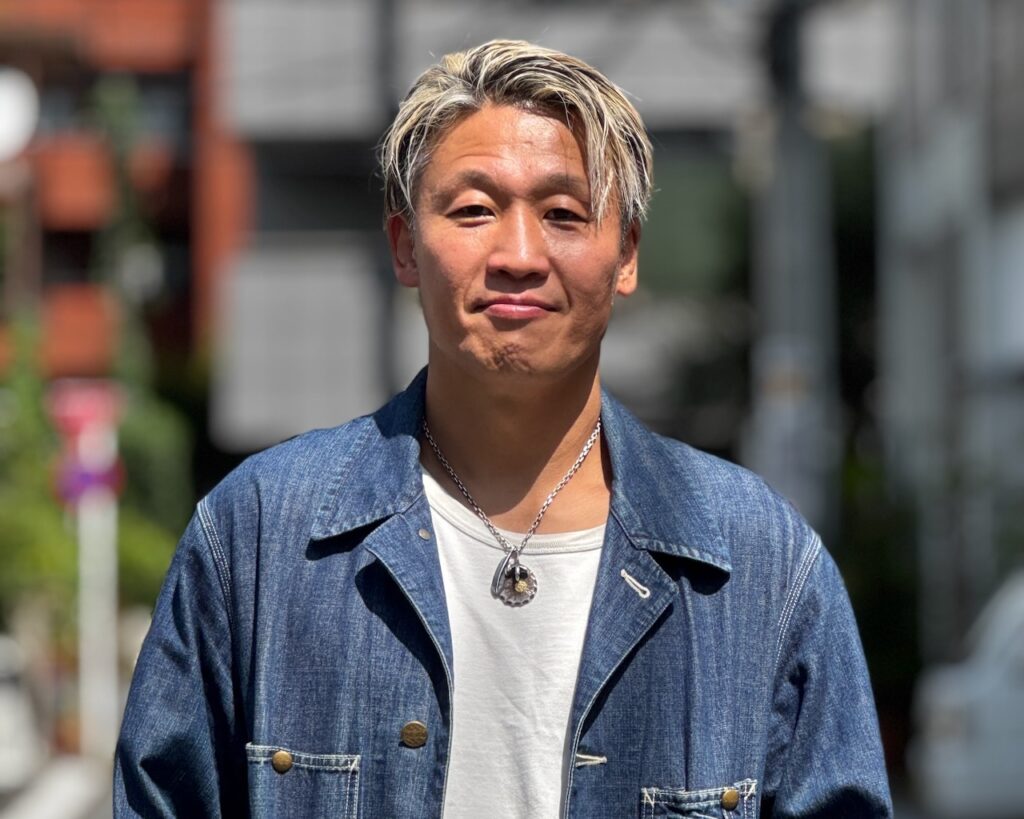Jelado is one of those brands that I’d often hear about or see on Instagram, but didn’t know a lot about. I’m not sure if it’s because I’m based in Osaka (Jelado is a Tokyo brand) or I was already so distracted by the many other brands I follow that it just didn’t take the time to investigate further, but when I finally did, I was blown away by the depth and breadth of what Jelado produces.
Always one to go straight to the source, I reached out to Jelado founder, Yohei Goto, and suggested that we meet up for a chat. A short while later, I found myself sitting in their beautiful flagship store in Ebisu, Tokyo, learning and laughing with Goto-san and his wonderful staff. Here is our conversation.
Japanalogue: How did you get started in all of this? What was your motivation for creating your own brand?
Goto-san: Well, I used to run a vintage shop, probably from about 2003 or so. It was good, but there was a point there where I had to ask myself, like, “Can I really see myself doing this for the next 30 years?” It was around this time that I also started to meet some of the bosses of the factories that were making stuff for the other Japanese brands that were up and coming around that time, and that got me thinking about the idea of starting my own brand even more.
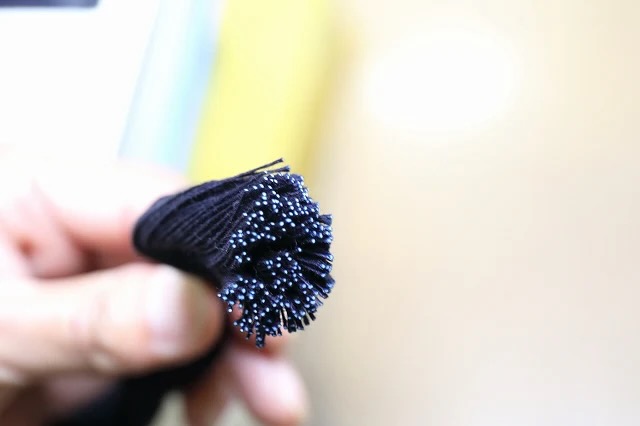
Ah, that’s cool you made those connections at the right time.
Yeah, so of course talk started about me doing something with them, and then in around June of 2005, I got started here in Ebisu, Tokyo. So yeah, we talked for like a year through 2004 and 2005 about a lot stuff, you know? I had never actually made clothing before then, so there was a lot to discuss. I didn’t know anything! (laughs)

For sure. So how did you even know what to make then?
Well, at least I had experience in the vintage world itself, so we started talking about what kinds of things I might want to make myself. Also, I did it in a kind of reverse order in that I had my shop open before I really had the brand up and running, so for the first year or so it really was a half-and-half mix of vintage stuff and stuff from my brand. People also weren’t all that used to paying high prices for Japanese stuff yet either, so I kind of eased into it.
How old were you then?
28.
How did you come up with the name? There must be some meaning behind that…I think everyone immediately thinks of Italian ice cream at first, but I suspect there’s more to it than that.
We actually all put our heads together (I mean and the staff who helped me establish the business) and yeah, you know the Italian ice cream of course, right? Well, I looked into the actual history of that, and it turns out it has a deep, deep history as a dessert, and we liked the idea that the main part of it was actually ‘old’, in the sense of being around forever, but that all the toppings could be whatever you wanted. So, the toppings might change with the times or what was popular at the time, but the base, the foundation remained rooted in history. Adding something new to something that was unchanging, deeply rooted.
Aha…I knew it was more than just a cute name.
Yeah, we saw it as a blending of old and new. And with the spelling, you know of course that it’s usually G-E-L-A-T-O, right? We changed that to a more Japanese spelling with a J and a D. And even that has a deeper meaning in Japanese. Haha…sorry, it’s a bit hard to explain, but yeah, we did put a bit of thought into it.

I can see that. So, was everything smooth from the start, or were there some bumps along the way?
Of course we ran into all kinds of problems. It took about 6 months to be able to sell any jeans at all, you know, being a new brand and all. So, it wasn’t like we just took off immediately. It wasn’t like today where it’s all on SNS and the internet – it was still basically advertising in magazines. And there were already so many famous and established Japanese denim brands at that point too, so it was tough. It would often happen that a new brand would start when someone in one of those brands quit and then branched off and started their own brand, so they had the advantage of already knowing everyone, and everyone knowing them. A lot of now famous brands started that way. I didn’t start like that. I didn’t know anyone, and they didn’t know me.
You had no mentor or teacher to point you in the right direction?
No, not really. That was the toughest part. But I did get help from Lightning magazine, which was super popular even then, and we slowly began to run little ads for Jelado. That was my start.
What the toughest part from a production standpoint? You often hear that new brands can’t get a steady denim supply, nobody will take on their sewing work, etc.
Actually, I was pretty lucky in that regard. The reason was that I kind of had ‘investors’ at the beginning, and they already knew people in the factories that could do everything we needed to get started producing products. So it worked well in that I did all the planning and designing, and then they were able to take care of the manufacturing end of it. So I was a bit lucky in that; even though I didn’t know much about that end of it at first, we were able to start making and releasing stuff right from the start.

That sounds good. I know it doesn’t always work out that smoothly, especially at the beginning. What did you make first?
War model jeans. I also made a tank top back then, but yeah, I was wondering like, “Is anybody gonna really buy something like a tank top?!” (laughs). But that was my image back then of what I wanted to make at first, and then that led to outerwear like jackets and stuff. The first months though, yeah, our money ran out fast and we were in a bit of trouble, and I even had to go to the bank to get a loan just to keep going. We were in trouble.
Yikes.
I quickly learned that, even if you make great stuff, if nobody knows about you or your brand, how’s that going to work out? You’re in trouble. There were already famous brands doing their thing, so even though I had made what I wanted, I needed to somehow get the word out about what we were doing. Lightning magazine was a real help in this regard, with advertising. It had a real effect. And the one guy you saw earlier that now works for me, he actually worked for Lightning at that time.
Ah wow…there’s a story there, for sure.
He really helped me at that time, you know, giving suggestions and things like, “Goto-san, there’s a clothing event coming up next month and I think you should go”, and stuff like this. For example, you know the big event Inazuma Festival right? The huge one every year?
Yes, sure.
Well, the very first time it was held was 2005, so I went. This is the time I’m talking about…I was blown away by what I saw there. Suddenly, there were literally thousands of guys wearing ‘sukajan’ souvenir jackets, like just everywhere. I had always loved those and had acquired a lot of vintage souvenir jackets by that point. I mean, I would have loved to make my own, but up until that day, I didn’t imagine that I could realistically sell such things. I mean, if they were new items I had made as opposed to vintage ones (which I had sold a lot of earlier). So when I went to that festival, I was like, “Oh man! I totally should make a sukajan!”
Haha..I can just picture all these dudes milling around in their souvenir jackets. That must have been like a real “Ah ha!” moment for you.
Totally. I got back and started planning my own souvenir jacket right away. I got the rarest vintage example I had and decided to make a replica of that. We advertised it in Lightning, and suddenly the phone was totally blowing up with interest. Around that time, a standard price for a reproduced sukajan was about 50,000 yen here, but ours were going to end up costing a bit more, just over 60,000 yen. So, I went against the current and chose a hardly-ever-seen embroidery for mine.
Like what?
Well, you know the usual souvenir jackets tend to have really similar themes and symbols like dragons, tigers, etc, right? I went in totally the other direction and reproduced this rare ‘Alaska’ sukajan with a huge walrus on the back and polar bears on the front. (Goto-san pulls out the original vintage souvenir jacket, and sure enough, it’s awesome and does in fact have a big, bearded walrus on the back and two polar bears on the front chest).

That is fantastic. Wow. I’ve never seen one like this.
There aren’t many around. So I made this, and a ton of shops ordered it. Our name started to build from there.
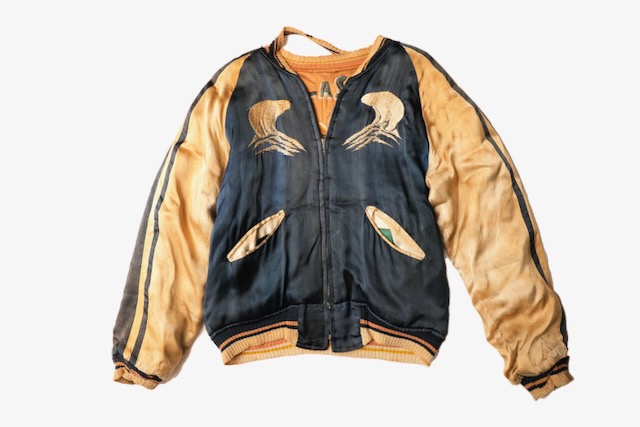
That’s a pretty cool way to jump into what would have been a very crowded market.
I think so. You have to remember that this was over twenty years ago, so as we were discussing, many established brands already had their core items and their customer base. And shops would have their set opinions too, like if you want jeans, you should buy this brand. Or, if you want flannels, buy this other brand. So it was nearly impossible for a new brand with no following or brand cache to just show up and compete with those brands on those particular items. So I started to try and ‘get into the spaces’, so to speak, meaning making things that were unique or that other brands weren’t really making. I loved those unique kinds of things anyway, but it was also a business decision at the time because I saw the only way to really get into a crowded market was to start off making rare items that other brands were not making.
That makes sense.
Yeah, so I kind of laid off making jeans for a bit and branded us as a brand with a twist, a company that was doing unique things on its own that others were not really doing.
Were you satisfied with what you were making right off the bat?
Haha, no way, not at all. Jeans, especially. They’re hard. I know that in the last five years or so people are seeing Jelado as a ‘denim brand’, but it wasn’t that way back at the start. If you go back fifteen years, nobody thought Jelado = jeans.
Yeah, to be honest, I always saw you as primarily a denim brand. My bad.
Right? Yeah, it’s true (laughs). It was partly out of necessity back then because people already had their favorites in the jeans space. Even all the select shops (shops who sell various brands) were like, “Yeah, we’re good for jeans already. We’re already satisfied the brands we carry”, so we needed another way in. Sweats and stuff like that. So, I kind of put the jeans part on hold for a while until we built up the other parts of our collections.

Currently, do all patterns, designs, items, etc. come directly from you?
Yes, but we also work with people like Suzuki-san who runs 2 Monkeys brand, so he takes care of all that part.
Do you feel any difference in what Japanese customers want and what overseas customers want?
Hmmm, good question, but I think that, when it comes to jeans anyway, what customers have asked for over the past few years is kind of the same regardless of where they are from. To be honest, we’ve never really been too careful about just making what we think people might like. I mean, we wanted to make rare, vintage items that we ourselves liked. Before 2020, I guess my feeling was really to make things others were not making, so until recently, I guess that really guided my design decisions up until about the past five years.
Interesting. A lot of brand owners I talk to say that they purposely never look at what other brands are doing, I think so that they don’t get influenced or something. Are you like that, or do you like to know what the other brands are doing?
These days, I don’t really check too much, but yeah, back then I did. Well, not like checking in any kind of detail, but yeah, when I was at a shop I might ask them what they like about a certain brand or why they carried a certain brand just to learn a little bit of what others were doing. But it was more of like what concept a brand had or was putting out there rather than literally looking at individual items from different makers.
I get it. Makes sense to have at least a general idea of who your ‘competitors’ might be.
Yeah, it just seems kind of natural. I mean, these select shops are selling various brands, including your own, so it’s just kind of a natural conversation to get into, like, why they carry this brand or why they like another brand. It’s useful to know why a shop might prefer a certain brand’s item over another’s, right? To be honest, I find it hard to believe that any brand owners would literally “never look”…haha, maybe that’s just something that sounds cool to say in an interview.
You might be right there. It makes sense to have a general idea of what’s out there, I would think. It’s all good information, especially if your items are on the shelf beside theirs.

And so, at some point, once we were really established and doing our thing, my thoughts turned back to jeans. I wanted to give it another try, but in all earnest this time. Luckily, I had a friend who was a very trusted fabric dealer and dealt high-quality selvedge. He also works for me now…(laughs).
Haha…wow. A good person to have around.
We made an office in Okayama as well, and so he’s working out of there. We did this because, if we were going to make jeans again, we wanted to get right into the deep research and creation angle. This is going to go deep, but basically, we’re all trying to replicate jeans from 70 years ago, 100 years ago, right? So, we have all these Japanese brands all trying to recreate essentially the same things, the same vintage jeans models, while of course adding their own little bits of flair according to their own interpretation of the classics.
Yes, that’s essentially what the reproduction brands are doing. How did you arrive at your own original denim?
I first had many discussions with fabric merchants in order to create new denim, but I just couldn’t arrive at a fabric that I could call original or “one-of-a-kind” in a way that I was 100% satisfied with. I didn’t know what to do for a bit there.
I can imagine. So what did you do?
Well, that’s where the particular denim dealer that I mentioned earlier comes into to the story. I asked him directly, saying “I want to make XX jeans. What’s the best way?” His immediate answer was, “I think you really need to dissect an actual vintage pair and start from ground zero. That’s the only way if you want an actual original denim based on real vintage jeans.” I was a bit taken aback initially, you know, to chop up a real pair of vintage XX. I mean, people normally use loupes and microscopes to more-or-less guess what the construction and composition of the yarns were, but unless you literally take the threads themselves apart, you don’t know things like staple length, twist, etc. He warned me it would be expensive though to have all that done properly, like in a proper laboratory with scientific measurements and all that.

Okay, wow. That’s a pretty serious undertaking.
It totally is, but I was also super excited because it meant that I didn’t have to just ‘guess’, and I could choose a favorite pair of my own vintage jeans, have that analyzed, and produce what would basically be the same denim all from scratch as our own original denim.
That’s super exciting. And it worked?
Well, firstly you need a bit of courage (laughs)! I’m not talking about a few-hundred-dollar pair of vintage, but like the rarest of the rare that was selling in the shop for tens-of-thousands of dollars. To slice a pair of those up takes a healthy dose of bravery!
Haha…yeah, I imagine it would. Obviously, you’d want to choose the best vintage pair possible if you are going to make that the basis for your brand’s own fabric.
Right. But I was determined to try it because I wanted to know and be able to say later that I had really spared no expense or effort in making what would become Jelado’s denim. So we totally unravelled a pair and sent it all to be analyzed at a national laboratory. We analyzed every bit of it and received all of our own data back.
Was it expensive to do that?
Sure, it cost money, but we now had all the actual confirmed data and numbers that we could use. And it was amazing to compare our data with other data that had been published and see that there are actually differences. Vintage jeans are definitely not all the same, just as reproduction denim is not all the same. We could now confidently say what was special or what was different about the denim we were going to reproduce.
That is super interesting.
We actually tore down two seriously vintage pairs. And it was cool to see that there were even small differences in the data and numbers between these two pairs, even though they were ostensibly supposed to be the same. So there were totally differences in denim back then even between brands that were thought to be using basically the same fabric. This means that our own original denim is also different from what others are making and is based directly on our own research and data collection. This was another one of those ‘ah-ha’ moments when I realized that all denim was indeed different, and because I had done my own in-depth research, the denim I reproduced from that data would indeed be different from what the other Japanese brands were making. It was at that moment I was convinced that my ‘original denim’ would truly be original.
And this was all going on between you and the fabric guys, not the actual weaving mill at this point?
Yes, but in our case, the ‘fabric guy’ also has weaving looms, so it’s kind of one thing. We don’t do our own dyeing there though, so for that we rely on either Sakamoto or Kaihara. But even between and within these factories the range of colors is different, so we actually separate our denim into the fabric that’s been dyed by Sakamoto and the fabric that’s been dyed by Kaihara.
You must go to Okayama yourself then to check on everything?
Of course, every couple of months I head down there.
To the weaving mill?
To all of it: to the mill, to the dyeing places, to the sewing factories. But more than being a strictly business or sales trip, it’s more about seeing the people that are actually creating our items and talking to them face-to-face and also just being in the areas where it’s all happening.
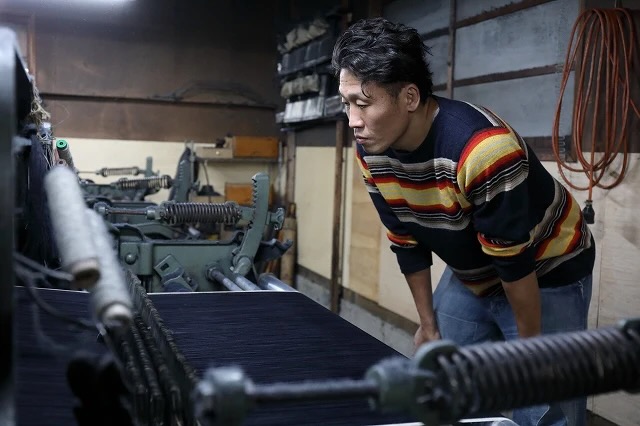
That’s important, isn’t it?
Really very important. Maybe it’s a Japanese thing, but I’ll bring souvenirs from here and go to each place to greet and thank them for doing such great work for us. That human element is everything.
Are there other brands that you like or like what they’re doing?
This is kind of a tough question, and this part might be kind of private, but I think every brand believes most in what they themselves are doing. I’m not really influenced by what anybody else is doing anymore because, as we talked about earlier, I’ve been able to deconstruct the exact vintage items I wanted to make and create them myself, exactly how I wanted, from the ground up. And each brand has their own way of doing things even when things look the same on the surface. They express it in a different way.
I get it.
Take this jacket for example (grabs a vintage denim jacket). It’s fairly well-known vintage style, and I’m sure other brands would also be reproducing it, but our stitching angle, thread thickness, thread color are different, and I don’t think there’s any reason to compare it to what other brands are making because we’ve made it exactly the way we wanted to, and that’s the important thing.
Are you friends with other brand owners?
Well, for example, the brands that you see in Clutch or Lightning magazine all know each other, so when we meet, of course we greet each other normally. I mean, we’re in no way enemies or anything like that. So, we’ll have dinner together or whatever at events and stuff like that.
Do you have a favorite item that Jelado has made?
Well, the ones I think are probably the most interesting are the native print (vests, sweaters). A lot of brands change the stuff they make every year, but this is something we continue to make every year.

Do you the change the pattern each time?
Not just the pattern but the fabric too. The fabric is made in the Bishu area between Aichi and Gifu. It actually used to be its own province back in the Edo period. And I’m also from Aichi, so…
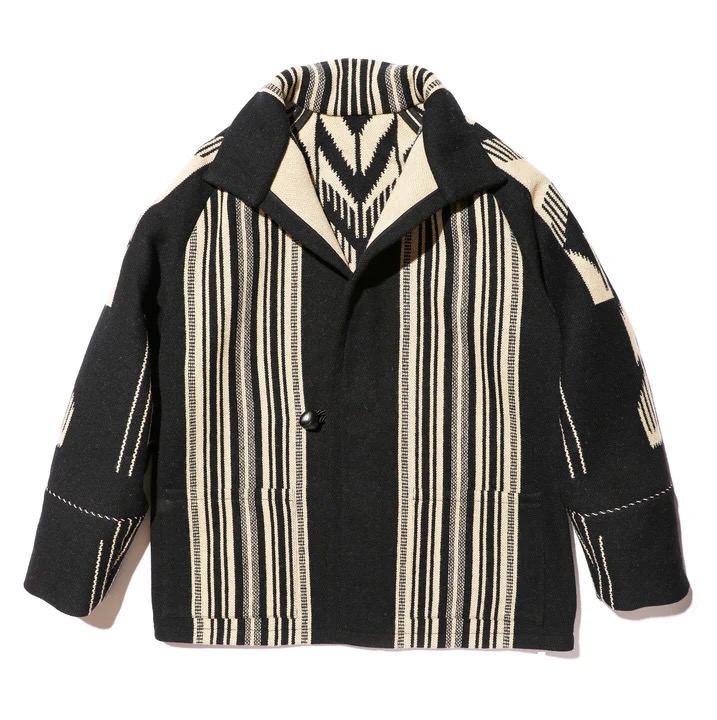
Really? Oh damn, I thought you grew up in Tokyo.
Haha, yeah, no. So it’s a cool combination of that area being able to make the best fabric for stuff like this and it’s also near my home area so I want to take care of that place as much as I can. So, we make it all there each year.
Why did you come to Tokyo?
Family’s work. Came to Kanto in my teens.
Something I’m always hearing is the worry around being able to secure a steady supply of good denim in the future. I mean, everyone is getting older, people who can fix and run the machines are disappearing along with a lot of the great sewing people. Is this a real worry?
It is. The next ten years are really going to be vital, I think. A lot of these people in the manufacturing end are currently in their 50s and 60s, so in another 10 or 15 years, most of these people will be retired, and they don’t have successors, people of equal talent to replace them. That’s the biggest issue.

Are you seeing an increase in overseas customers?
A massive increase. From what I can see, I think it’s because a lot of people are now really realizing the quality, depth, and originality of some of the things made in Japan. That’s my feeling, anyway. That’s part of the reason we opened an office in Okayama as well – not just for the creation of fabric, but also to keep our finger on the pulse of what’s happening there, to stay connected to the people and get information from there as well. I think this all contributes to quality.
What do you do about overseas sizing? Generally speaking, there can be large differences in average body shapes and sizes between Japan and other countries.
Yes, that’s right.
I mean, some brands just battle through and try to just use their existing ‘Japanese’ sizes, some brands are making a whole different line of overseas sizing, and still others are just using the shapes they already have but making larger sizes than they did in the past.
For us, I mean, well look at me. (Goto-san is a big, athletic dude – tall and long arms). My arms are long, so Jelado’s stuff has had longer sleeves than a lot of other Japanese brands right from the get go. Of course, there are some customers who are like, “Dang, these sleeves are long”, but I haven’t changed that. I’ve kind of used my own body as the base for our XL, so I think it suits ‘Western’ bodies, for lack of a better term.
That’s awesome, actually. A lot of people overseas will be glad to hear that. For me, a typical ‘Japanese XL’ is usually way too wide in the body, but too short. Or the shoulders fit perfectly, but the sleeves are way too short (if we’re talking about a long-sleeved shirt).
Right? We’ve kind of avoided that. I think Jelado fits people from overseas really well, again, probably because I used myself as the base.
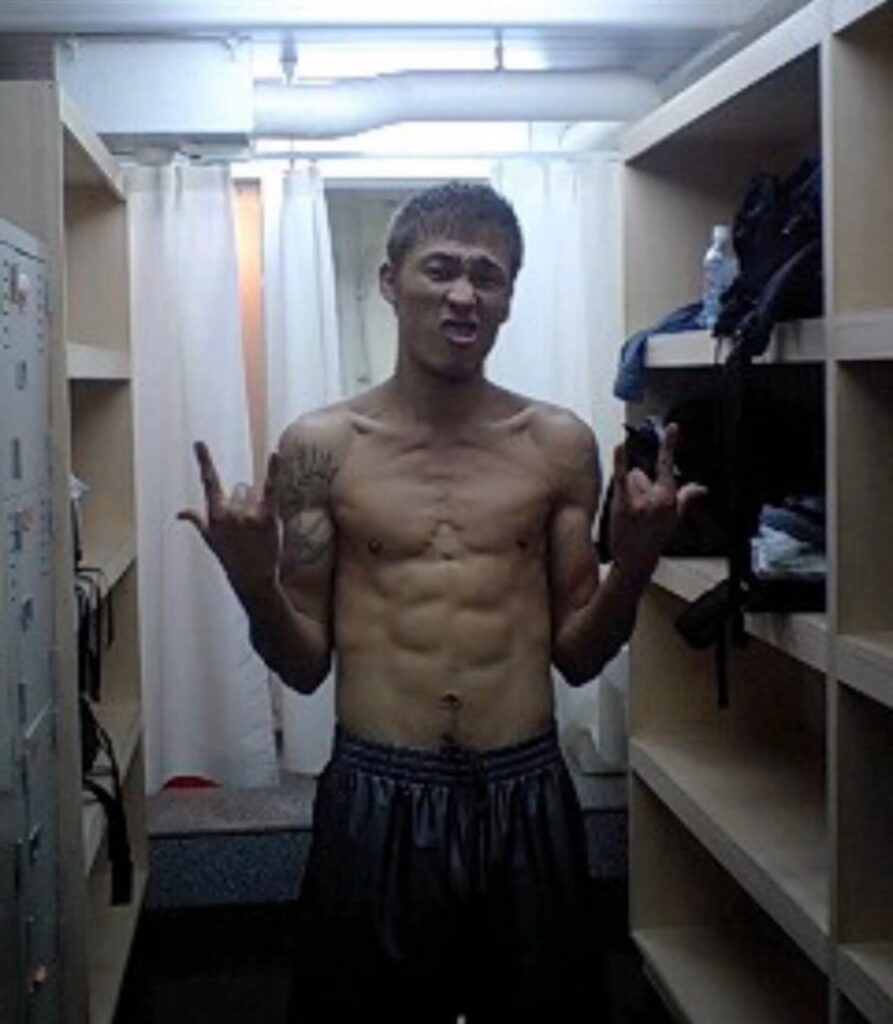
What’s the best and worst things about your job?
The best thing is that I get to create the clothing that I personally love (and actually sell it!) I mean, it’s amazing to be able to do that. As the boss, I can literally just create whatever I want, whatever I love and would want to wear, and then we have all these talented people to make it a reality. And then to see that others are also happy and want to buy it. I can make a living doing exactly that I love most. Being creative, making others happy, and making a living at it. That’s amazing, that’s the dream.
The worst part is the accounting side. Money, math, numbers. But of course this side of the business is unavoidable, and of course we need to look at the numbers. I also believe that, as a boss and as a brand, we should keep things positive, so I have to balance being serious about this stuff with also making sure we’re all enjoying what we’re doing. I guess it’s a balance, but I also try to keep an eye on myself to make sure I’m not injecting any kind of negativity or hard language into things at work, even if things aren’t going so well with the numbers side of things.
How would your describe yourself, personality wise?
Haha, well taking it in a positive light, I think that I always carry through on things I want to do until they are accomplished.
You mean you don’t give up.
That’s right.
What do you like to do outside of Jelado? Outside of work?
Well, I was a professional kickboxer for a long time. I was competing up until two years ago.

Wow, what?! Until two years ago?
Haha, yeah. To compete until you’re 46 in a sport like that is pretty rare, pretty tough on the body. People usually throw in the towel in their 20s or 30s, but I kept going. It was really my family, my wife that finally said, “I think it’s time to stop,” and I basically agreed with her and stopped. My family was always a huge support in my kickboxing career, so when they themselves are asking me to finally stop, then yeah, it’s probably time to give it up.
Wow. Well, I can certainly understand why they would say that. To do that professionally until 46 is pretty much unheard of.
Yeah, I was training 5 days a week. Running, hitting the heavy bag, sparring, getting ready for bouts.
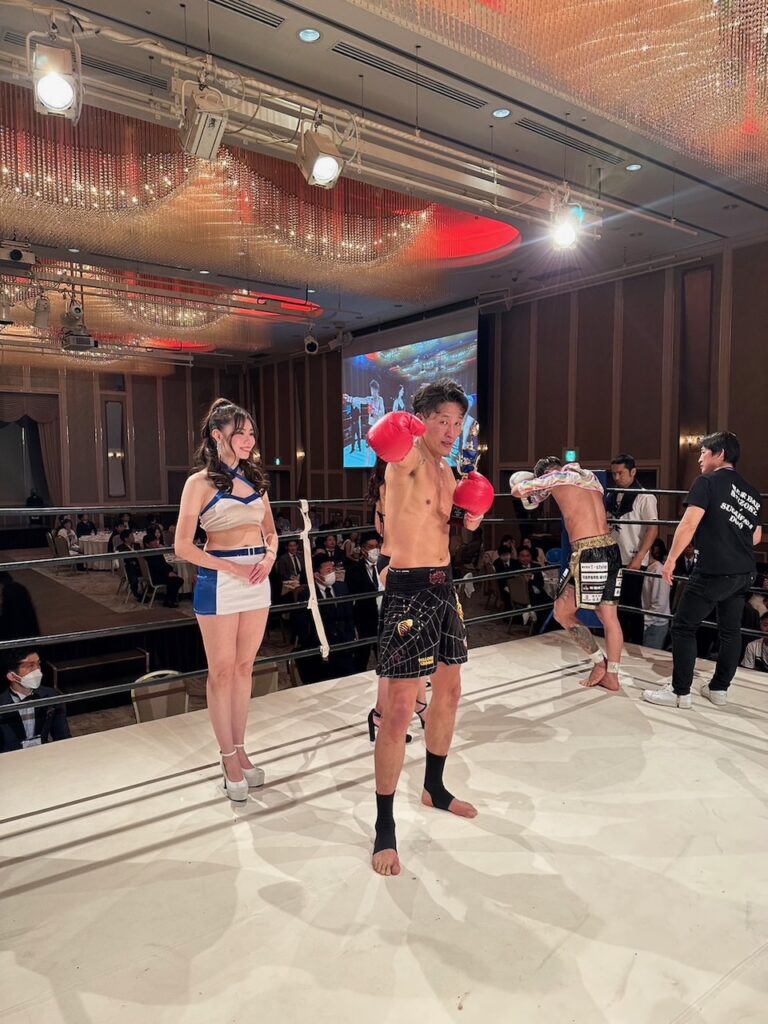
At the same time you were doing all the Jelado stuff we’ve been talking about?
Yes. It got pretty tough. But the funny thing is, after quitting something like that, you know, a routine that is so intensely physical, your mind and body gets kind of confused and is looking for a way to release all of that energy that was being channeled into what you’d been doing. I was kind of like, “Damn, what do I do now with all this power and energy coming up?” One thing I’ve taken up art – I go to a local painting school now.
Wow, I didn’t see that coming.
Yes, I’ve gotten into that lately. I also do weight training with a personal trainer lately. And there’s another thing…do you know what freestyle is? Like hip hop battle?
Yeah, I think so.
I’m learning that.
You’re learning that? What do you mean? Like how to ‘rock the mic’ kind of thing?
Exactly. I have a friend who is a fairly famous rapper, and I’m taking lessons from him. You’re probably wondering why something like that would appeal to me, but it’s actually super interesting. You have a tiny window of time to blast out impactful words and phrases to someone in a ‘battle’. It’s really an intellectual thing…haha. You might not think so, but someone will blast a question and you need to reply immediately with something that sounds good and also has meaning. It’s pretty intense…not easy at all.
Wow, I want to see that.
Haha, it’s a really powerful outlet. So all this is to say that I’ve taken up other things I enjoy to channel all that energy that I would normally have poured into my kickboxing training every day.
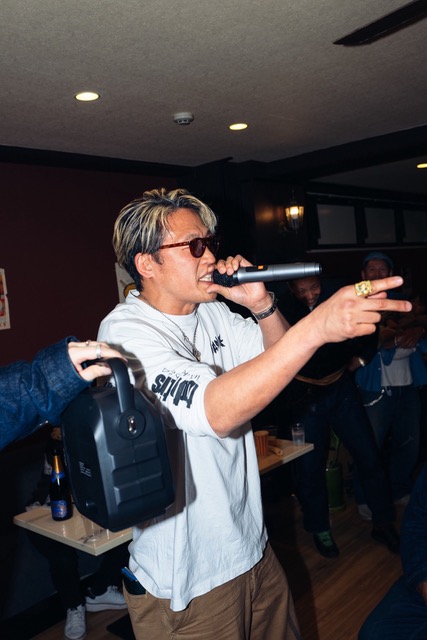
Odd question, but how was the whole Covid time for you guys? From what I’ve heard, some brands’ sales went through the roof while others really suffered. Seemed to be that the brands who already had a strong online presence took off, while those who didn’t saw huge drops in sales.
It was tough. Our sales went down. We weren’t really up to speed on the whole online thing yet when Covid hit. People just stopped going out to shops then, and a lot of our customers who would come to see us regularly just weren’t leaving home. So, we lost all those usual sales while the online part wasn’t making up for it, so we went way down. But, you know what, it was overall a great learning experience for us in that it forced us to totally rethink how we did business in an overall sense. We had to learn and adapt, probably like a lot of people did.
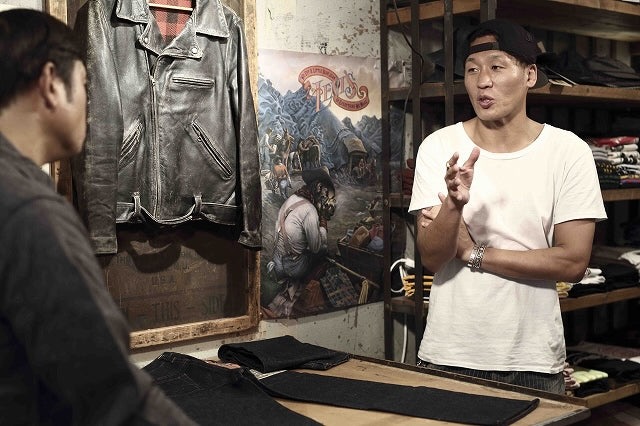
Yes, it really changed the way people work and do business, especially in Japan, it feels like.
We had about 2 years to think about it when we were in the depths of Covid here. Turned out to be a precious time for reflection, like, where am I headed in life? How do I want this brand to move forward? What are my real goals here, and how should I, as a boss, go about achieving those? I did a lot of thinking. To put it simply, Covid really changed me as a person.
Wow.
I’m way more forward thinking and positive now because of it.
So, at this point, if there are people overseas who would like to buy something from Jelado, what’s the best way to do it?
I think probably online is the easiest way at the moment, probably the easiest to understand. You can change the language on our website, and we’ve really worked on making our site fairly easy to navigate. Having said that, we are also now in the process of connecting with more overseas dealers, so that’s coming as well.
Is there a way for people to know who and where the overseas dealers are?
Yes, if you check out our official site, there is a dealer list. We actually have two sites – the official site and then the web shop site.
I think a lot of people ordering from overseas are worried about getting the sizing right. It’s always a bit of a risk when you can’t actually try things on before taking the plunge. How do you guys deal with sizing, returns, etc., as it concerns overseas customers?
We generally don’t run into exchanges because we take a lot of time with the customer beforehand, before ordering, to make sure the item is going to fit. Aside from having all measurements clearly posted on the web shop, I think we also have a good understanding of ‘western’ sizing. I mean, I’m pretty tall and over 80kgs, our store manager is 100kgs, so…we kind of ‘get it’ when larger people are buying Jelado stuff. But yes, we’re really careful beforehand so there aren’t any surprises or disappointments afterwards.
The yen has been pretty weak the past few years. Is that good or bad for what you’re doing?
Well, as a Japanese person, it’s just hard to hear something like, “The Japanese yen is weak” regardless of what that means in a business sense. It’s kind of a sad and lonely feeling from that point of view, but taken positively, business-wise, it’s meant that we’ve beeen able to sell more overseas or at least to overseas customers who come here. We have all these people from overseas who are maybe seeing this as a good chance to get something of such high quality for relatively low prices. Makes sense.
How do you guys handle repairs? Do you do them on-site here?
No, we don’t. We just do hemming here, but we do recommend places where people can have their items repaired, if needed.
Oh, I forgot to mention this before, but one thing that really struck me when I came into the Jelado main shop was the sheer variety of stuff you guys are making. I mean it seems like you’re making a vast range of items, more than I normally see from one brand. Isn’t is hard to keep all that going? Like socks, boots, shoes, leather jackets, sweaters, denim…like tons of things.
Ahhh, I see. I never thought of that exactly, but I think it’s because I started out running a vintage shop. Obviously, there are tons of different items in that environment. And there were already a lot of brands kind of focusing on one or two things and just doing that, so I kind of took things in the opposite way in that I had this store first and then created a brand to fill it with stuff. I wanted to make all the things that I like, and that was a lot of stuff. For me, ‘a store’ usually has a lots of things in it, right? And after doing this for 20 years, I guess it just kind of expanded. Like, I’d realize “I need some more socks”, so I’d start making them. Or, “I need this kind of shirt”, and then we’d make that too. So, it often came from what I liked or actually needed in my own life. Haha…we make pretty much everything except underwear.
Are they next?
Ha! Nah, I’ll probably leave the underwear to others.
One other thing I’ve noticed about Jelado is that you guys have a pretty active YouTube presence, relatively speaking. Was this a conscious effort you guys made?
Yes, it was. During Covid we started to do it as a way to explain items to people who weren’t actually coming in to the shop, explaining sizing and things like this in YouTube videos. But it was tough at the start because we didn’t really know exactly how to do it and the number of followers or subscribers seemed stuck at a super low number, but slowly it improved. We made sure to post videos regularly, and we still do that same routine even after Covid. I think a lot of brands started doing something similar, but then kind of gave up on it once Covid cleared up. We just kept going. I think we might have like 8,000 subscribers now, so it’s great and we’ll keep at it.
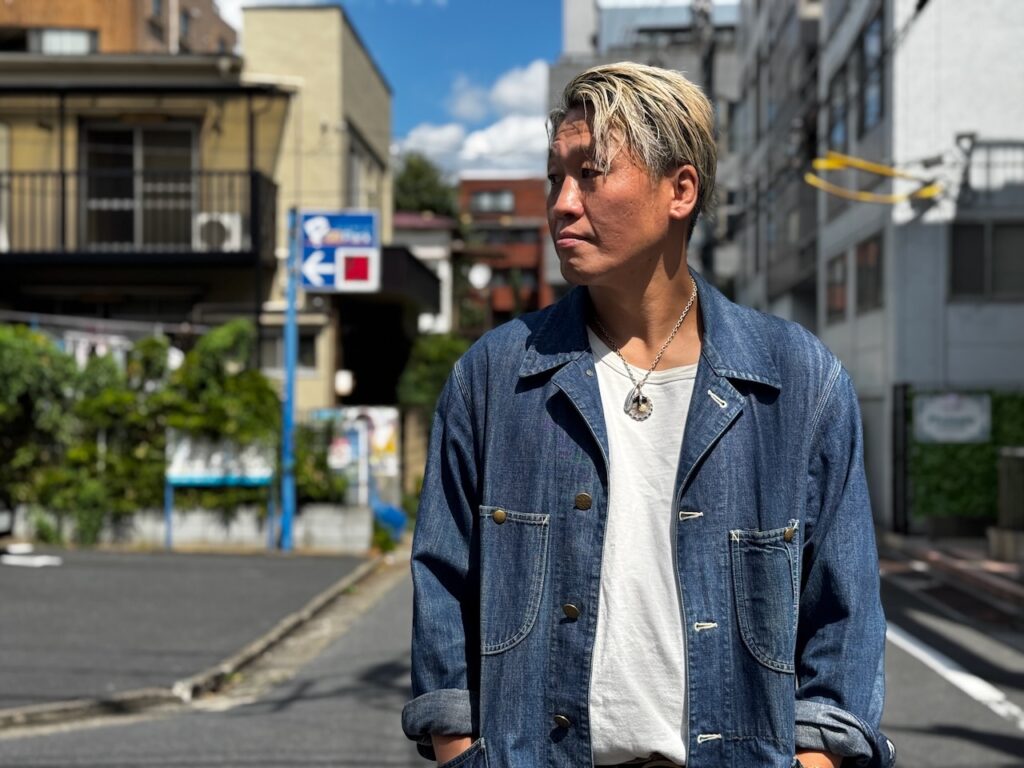
That’s great. I think a lot of brands want to get into it, but they don’t really know how to approach it.
I think one good thing about our staff is that they can all just talk naturally in front of the camera and kind of have fun with it, so I think it comes across as lighthearted and believable. I consider that one of our strengths.
Finally, do you have any message or something you’d like to say to everyone out there, many of whom might not be so familiar with Jelado?
I know there are so many brands out there to choose from, each with their own charms and strengths. Continuing on from what we just saying, you know back in the day when we first started, the only way to advertise was in magazines. This took a lot of time and effort and you can’t really get stuff out there quickly or in a personal way. With YouTube, we explain things in our own way, in detail, so I would ask that those who might be interested have a look at our channel where we talk about things in real detail, like how each thing is made, how we suggest styling it, etc. You can also get a feel for us as people as well as the products. You can really get to know us from there. Please check it out if you like.
But wouldn’t that all be in Japanese?
Yes, but I think these days you can actually change the language on YouTube.
Oh wow, yeah, then that would be super useful in learning more about you guys and your products.
But even with that, lately we are trying to also upload videos done in English and Korean, when we can. We have staff who can speak those languages, so even if you can’t get the auto-translate thing to work on YouTube, hopefully you can soon see some new videos in English and Korean. I don’t want to compare ourselves to other brands, but to be honest, I think we put a massive effort into explaining our products to people in a lot of detail, so again, I consider this one of our strengths, and it would be great if people checked this out. We want people to feel good and understand everything, so we take the time to do that.
Well, Goto-san, this has been a great chat, and I want to thank you for taking time out of your busy day to let us all know about you and about Jelado. You were super easy to interview (laughs).
Really? Haha, was it okay? (laughs). Well, thank you too for coming up to Tokyo – that was a good chat.
It was, and I’m sure people are going to enjoy it.
Great. Thanks again.
Jelado homepage: https://jelado.com/

